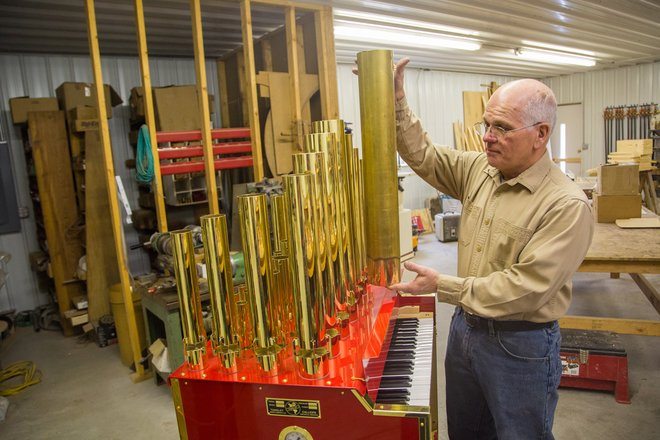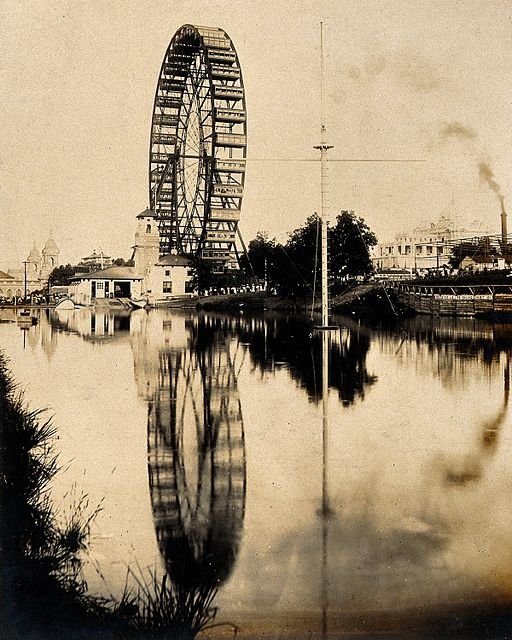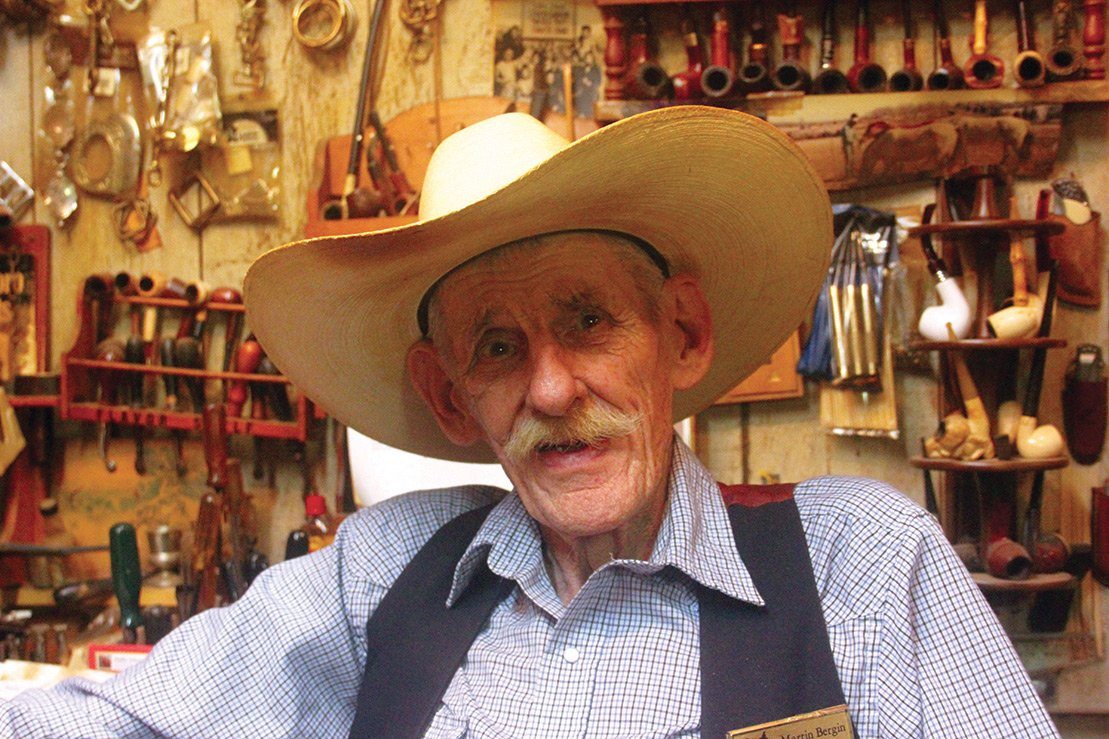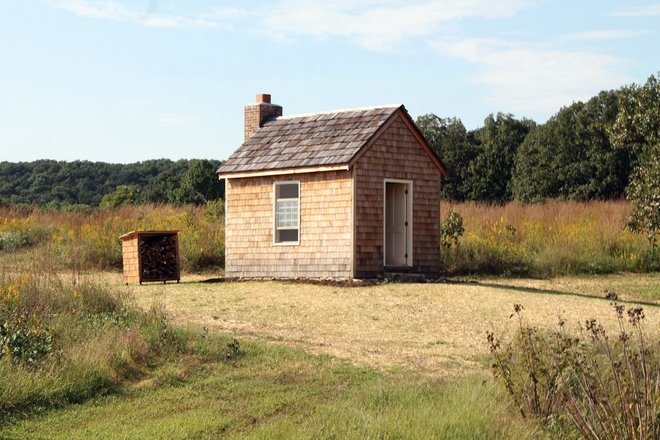“To draw passenger travel the owner … had a steam calliope … a new musical instrument at the time, placed on board the vessel. On her first trip up the river with the calliope numbers of residents for two or three miles on either shore … came down to the water to ascertain where the floating music box came from … It was employed as an advertisement … and it proved a drawing card by its novelty, for the daily passenger list was almost double what it was before its installation.”
—History of American Steam Navigation by John Harrison Morrison (1903)
Norman Baker and Dan Dohman could hardly be more different. Norman, who patented the Tangley Calliaphone in 1914, was a purple-wearing, attention-craving showman, radio crank, and phony cancer doctor. Dan, who builds Tangley calliopes today, is a quiet, religious man who methodically crafts “better, stronger” replicas of Norman’s ingenious, mechanical music contraptions in the shop behind his rural northeast Missouri home.
“It’s safe to say we’re the only company in the world that builds calliopes,” says Dan, the denim-clad owner of Miner Company LLC, a one-man operation set amid the rolling, green prairies east of Kirksville.
His neatly ordered shop is fragrant with machine oil and sawdust. Brass whistles, in graduated lengths and diameters, gleam on a worktable. Dan hefts one of them and screws it into a fitting on the top of a fire-engine-red cabinet. Below that shiny metal panel is a five-octave keyboard connected to a manifold of pipes that distributes compressed air to the proper whistle when a key is pressed.
The market for calliopes these days is “narrow,” Dan says. “I’m amazed how few people even know what a calliope is.”
Not Ear Candy
Even those who know the name are unsure about the pronunciation—kah-LIE-o-pee or KAL-i-ope. You hear it both ways. Vachel Linday didn’t help matters when he published this ditty in Reedy’s Mirror in 1877:
Proud folk stare after me,
Call me Calliope;
Tooting joy, tooting hope,
I am the calliope.
Norman Baker sidestepped the issue by calling his device a “Calliaphone,” but its lineage traces to the first steam calliope, patented by New Yorker Joshua Stoddard in 1855. Stoddard named his creation for the “beautifully voiced” muse of Greek mythology. Its sound wasn’t exactly ear candy per this period description in Mechanical Music Press:
“It played awful music. It was too loud for comfort and, despite the fact that its manipulator was as much a plumber as musician, one never found a calliope with all whistles in tune at one time. The back end of a calliope wagon contained the upright boiler and an attendant kept it stoked with coal or wood so there was plenty of pressure whenever the player decided to render Over the Waves or Go Tell Aunt Rhody. The raucous hoots and toots of the calliope served like the pipes of Pan.”
The steam calliope’s scalding vapors, massive size, and limited musical scale found redemption nonetheless in its peerless ability to send an unmissable message that the show was in town.
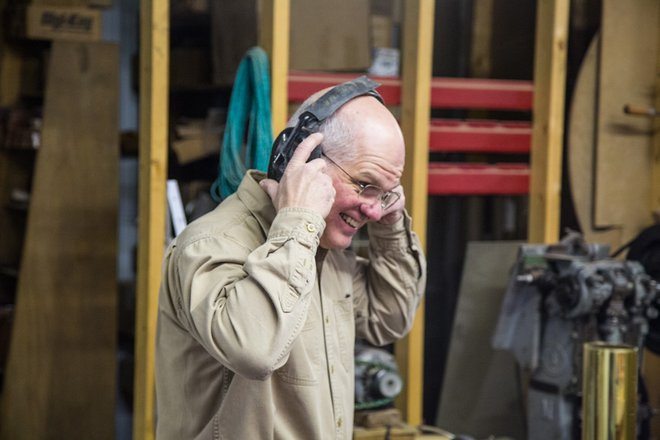
The Mentalist Musician
Norman Baker, who had grown up watching calliope-summoned crowds greet Mississippi steamboats in Muscatine, Iowa, saw potential in a portable version. A traveling mentalist who owned part-interest in a metal shop, he developed an air-powered calliope and planned to mount it on a car to promote his show. Whether he actually invented it is subject to dispute. He may have been piggybacking on the work of Joseph Ori, whose air-powered calliope came out in 1905.
Norman’s device—named for Madame Tangley, a mind reader in his act—was easy to transport and play, had a wider musical range than steam models, and could be heard for a quarter mile. Using paper rolls like a player piano, it could also operate automatically.
The Tangley was a hit in that era of boomers and hucksters. An opportunistic entrepreneur, Norman turned to manufacturing and was soon earning $250,000 per year making calliopes and other products while running a correspondence art school and mail-order business. But after a career hawking phony cancer cures and running a radio station that blasted national tirades against Jews, Catholics, and the American Medical Association, Norman was imprisoned for mail fraud and died of cancer in 1958.
The Tangley and its competitors seemingly reached the end of the line around mid-century as well. Kansas City-based National Calliope sold its final new unit in 1950 to the Hadacol Show, one of the country’s last traveling medicine spectacles, according to the entertainment trade journal Billboard. Hadacol caravan promoter Dudley Leblanc, aka Cousin Dud, employed celebrities such as Bob Hope, Carmen Miranda, and Jack Dempsey to peddle case after case of his 12 percent alcohol, cure-all elixir.
Despite the seedy associations, calliopes were and are intricate, finely crafted instruments, valued by collectors, musicians, and entertainment venues. Thanks to Dan Dohman, there is someone to repair them and build new ones.
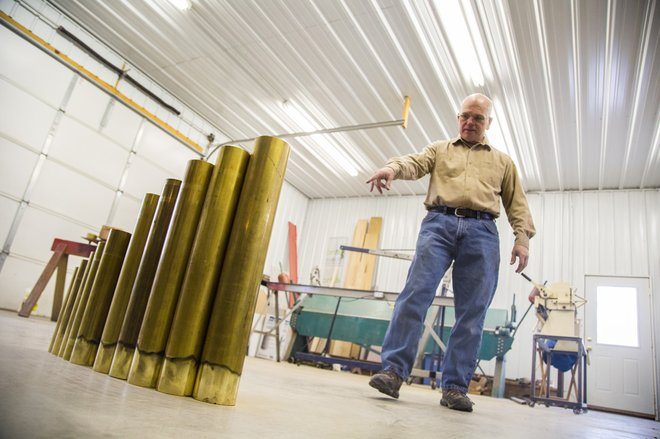
Return of the Tangley
The Tangley business had been “dead and done sixty or seventy years,” when Dan’s former employer, Dave Miner, picked up the brand name and began building replicas in Fort Madison, Iowa. Dan worked for years as Dave’s righthand man and bought the business after his death in 2008.
Serial numbers indicate about 1,300 Tangley calliopes have been built. The Miner Company accounts for more than 325 of those. Dan estimates there are about 2,000 calliopes in the world, counting those from other manufacturers.
One Tangley that many Missourians have likely heard sits aboard Hannibal’s Mark Twain excursion boat. Miner custom-built that calliope a quarter century ago. Dan, who had helped produce the original, modified the calliope to play electronic files a few years ago and won the admiration of the boat’s owner, Captain Steve Terry.
“He’s awesome,” Steve says. “After Mr. Miner passed away, we were concerned about who we were going to get to work on it. It was a blessing for us to get it upgraded and keep it running.”
Dan offers repair service and turns out about one new, improved Tangley per month. He works alone, except for occasional help from family members. He also crafts popcorn wagons, another bit of Americana.
Modern Tangleys—like their older counterparts— get their unique sound from sets of tuned brass whistles that expel air from 360-degree windways. The tubes of a pipe organ, in contrast, have a one-directional notch on each pipe face.
Except for some precision metal-cutting at a welding shop and pre-made keyboards, Dan creates Tangleys from scratch. He fabricates housings with a sheet metal brake, applies powder-coat paints, builds wooden cabinets, machines the fittings and cuts, and polishes and “voices” brass whistles. He equips Tangleys to play themselves, either with paper rolls or electronic components that accept MIDI (musical instrument digital interface) files.
Dan will customize a calliope for his customers—all red or black, all brass, taller or shorter—but he has no personal preference. “My favorite is the one I just sold,” he says. That could be the one thing he and Norman Baker have in common.
In a world of change, calliope music has a timeless appeal with an undiminished ability to draw a crowd. “It tends to put people on the street in a good mood,” says the Mark Twain’s Captain Terry. “It definitely draws people to the riverfront when we play it.”
Related Posts
May 24, 1904
The ferris wheel at the St. Louis World's Fair was tested for the first time. It stood twenty-five stories tall and could carry two thousand people
Meet The Saddlemaking Cowboy Poet of Missouri
A widower since 2011, Martin still surrounds himself with the stock in the trade of saddle making. His workspace is as much a museum of leather crafting as it is a saddle shop.
Meet the Holy Trinity of Conservation on a Missouri Farm
The Holy Trinity of Conservation takes place at Prairie Star Restoration Farm in Bland on Saturday, June 3. Tickets are $20 for adults, and $10 for students. There is a special reserved evening dinner on June 2 for $100 per person.

